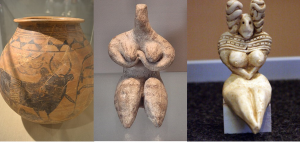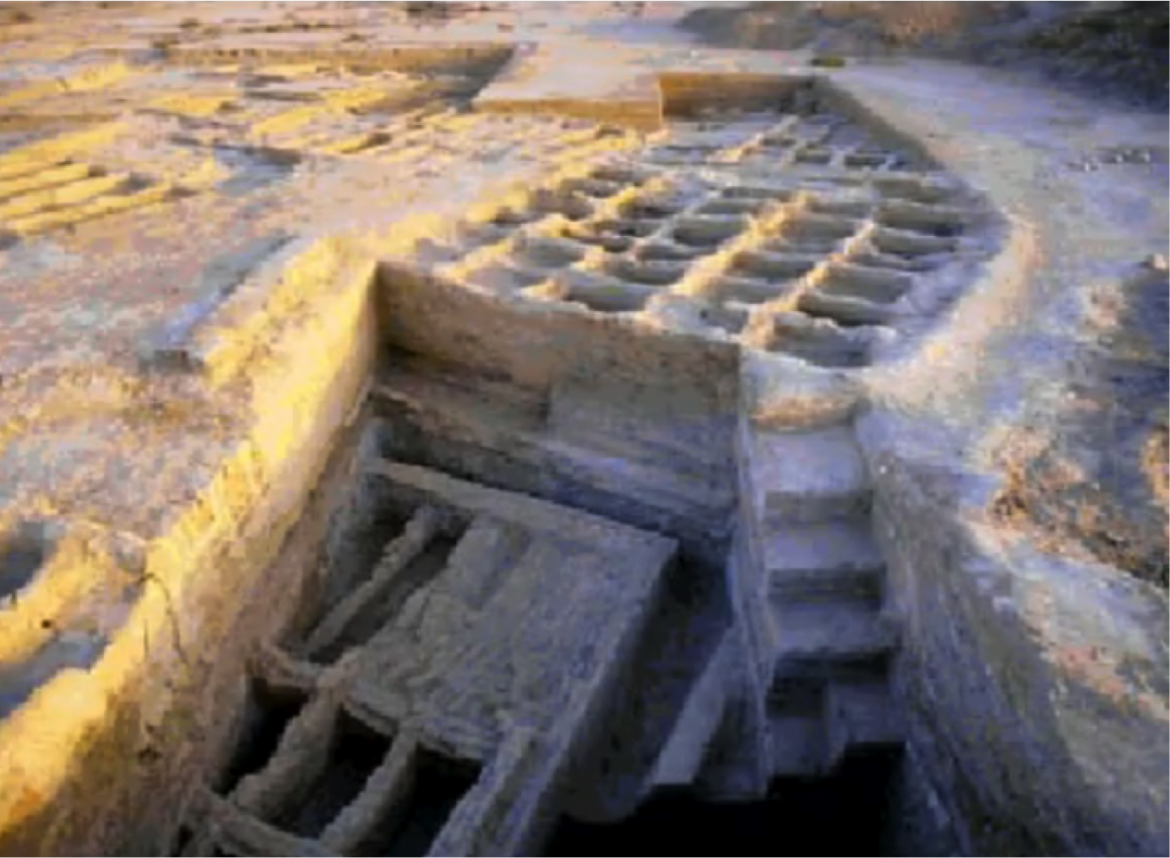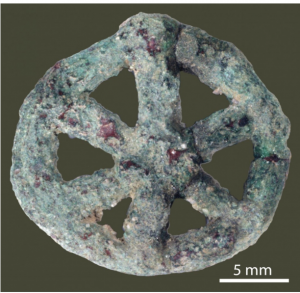687  Traditionally, deceased individuals were buried at burial sites with ornaments, including both individual and mass burials. Notably, women’s graves contained more ornaments and items than men’s.
Traditionally, deceased individuals were buried at burial sites with ornaments, including both individual and mass burials. Notably, women’s graves contained more ornaments and items than men’s.
Table of Contents
Mehrgarh a Precursor to the Cradle of Civilization- the Indus Valley Civilization
Mehrgarh, an ancient archaeological site of Neolithic inhabitants, emerged unexpectedly due to the erosive force of floodwaters in 1970. This once-thriving settlement shifted its location (the reason why is still unknown) over time, leaving behind a rich treasure of artifacts and history. Sophisticated housing structures, granaries, and meticulously crafted pottery and tools reveal the adaptability and craftsmanship of the Mehrgarh people. Intriguingly, this society flourished without any known large-scale conflicts with neighboring civilizations, such as the Near East Civilization, rather they developed trade routes and peaceful interactions. As we observe deep into the layers of Mehrgarh’s past, we unravel insights into daily life, innovation, gender roles, and the absence of religious strife—a legacy that echoes through the epochs of human civilization.Mehrgarh the Neolithic Site Location
The Kacchi Plain of Balochistan in Pakistan is the home to the most ancient civilization’s archaeological site that dates back from the Neolithic period in 7000 BCE to the Bronze Age 2500/2000 BCE. This site of civilization is known as Mehrgahr or Merhgarh, which translates to ‘the heaven of love.’ In the local Balochi language, ‘Mehr’ means love, and ‘ghar’ means heaven. Undoubtedly, Mehrgarh (located in Pakistani cities Quetta, Kalat, and Sibi) is the precursor to the cradle of civilization, the Indus Valley Civilization.Neolithic Era and its Origin
Before diving deep into the Mehrgarh site, let’s talk about the Neolithic era and its people. The Neolithic era roughly began around 12000 BCE after last ice age ended exposing the fertile fields for the shift from hunting and gathering to permanent settling and engaging in farming and domestication of both crops and animals. They required a permanent place to raise their cattle and crops, and land along the larger rivers proved ideal for both agricultural and residential purposes due to the ample water resources and fertile soil. The mighty River Indus plains were one of those areas. This transition from a nomadic lifestyle to settlers marked a significant change. In the Neolithic era, people learned the use of polished and ground stones. These tools weren’t just for farming—they had other purposes, too. They crafted pottery, built shelters, and even made chariots. Yet, with progress came shadows. Ethnocentrism cast its veil, dividing people into “us” and “them.” Social hierarchies grew, and the land yielded both bounty and strife. The toil of farming, demanding and unyielding, replaced the chase of the hunt. The strong became landowners, and the weaker became slaves or workers. And women, their vulnerability etched into their bodies, as they were burdened with increased agricultural responsibilities and received less sustenance compared to the earlier hunter-gatherer lifestyle. This expansion of Neolithic lifestyle had broader implications, affecting not only human societies but also wildlife habitats, land ownership, and resource competition, ultimately reshaping the global order. Some researchers believe that farming originated in Fertile Crescent (Middle East). Others argue that farming and animal domestication arose independently in various parts of the world such as the Levant, Anatolia, Syria, northern Mesopotamia, and Mehrgarh after the ice age. However, there was significant movement across these vast civilizations due to their physical connection, allowing these groups to exchange expertise and innovations. This contrasts with the inhabitants of the Americas and the Pacific, who predominantly maintained a Neolithic level of tool technology until the arrival of Europeans. Within this context, the origins of Mehrgarh’s inhabitants have sparked debates. Some scholars suggest a Near East influence or migration from regions like Mesopotamia, pointing to similarities in farming practices and artifacts. Others argue for an independent origin, citing Mehrgarh’s uniqueness and evidence of population change over time. The site’s strategic location, serving as a gateway between East and West, adds another layer of complexity to these discussions.Mehrgarh’s Timeline and Abandonment and Rediscovery
Since Mehrgarh is 9000-1100 years old, it doesn’t mean everything discovered dates to that time. The site reveals layers of civilizations from 7000 BCE to 2500 BCE, later developing into a more advanced stage, “The Indus Valley Civilization.” While localities shifted, they remained close to the original Mehrgarh site. Over five millennia, the site was redirected to Naushero, just six kilometers south of the original site. Mehrgarh was eventually abandoned and covered in alluvium, forming tell-like mounds. The abandonment of Mehrgarh didn’t mark the end of the great civilization; instead, it evolved into more advanced and literate urban civilizations like Mohenjo-Daro, Harappa, and Taxila in Pakistan, and several in India. However, our focus here remains on Mehrgarh. According to the ethnic analysts Lukacs and Hemphill, the residents of Mehrgarh exhibited more affinity with that of the civilizations located further in South and East Pakistan and Northwest India than with civilizations at the exact location or closer to Mehgarh, originating around 2600-2500 BCE. Additional dental evidence from Mehrgarh reinforces the fact that the Chalcolithic population at Naushero (2500 BCE) did not descend from the Neolithic population of Mehrgarh (7000 BCE) based on their distinct DNA from the original Mehrgarh inhabitants. The inhabitants of Mehrgarh probably migrated to the Indus Valley as Balochistan’s climate became more arid between approximately 2600 and 2000 BCE.Evidence of Early Domestications: Animals and Crops
During the early phases of the Mehrgarh civilization, people herded goats, sheep, and cattle. They cultivated wild six-rowed barley, domesticated einkorn, and emmer wheat. They collected wild Indian jujube (a sedative plant used in ancient Indian and Chinese herbal medicine) and old date palms (Phoenix dactylifera). However, by 4000 BCE, about 90% of the barley was locally domesticated, and wheat was likely acquired from the Near East or the Fertile Crescent civilizations. Alongside farming, they hunted water buffalo, wild pigs, swamp deer, nilgai, chital, and even elephants. As their food production grew, they needed storage for their surplus seeds. This shift towards agriculture and storage led to a more settled way of life focused on tending to crops and supplies.Archaeological Discoveries: Housing Structures and Granaries
The earlier houses at Mehrgarh were quite advanced, constructed with cigar-shaped mud bricks that were not baked but held together with mortar. These freestanding houses took on rectangular shapes. Over time, these bricks were replaced with sun-dried bricks made from molds, resulting in more symmetrical buildings. The architectural style evolved from freestanding rectangles to rectangular buildings divided into smaller compartments or units. Some structures lacked doors, suggesting they might have served as storage units or granaries. Other buildings housed craft-making areas. Notably, bead-making began early in Mehrgarh’s civilization, with artifacts providing ample evidence of this craft scattered throughout the site. In the later periods, buildings became more advanced single structures, including residences, cattle houses, storage, and workspaces. A notable feature is the pebble mix in clay foundations, a clever solution that shifted from freestanding rectangular structures to multi-unit buildings. Evidence points to a canal or proper sewerage system running alongside compact houses in the final period of the Mehrgarh civilization. Some houses featured courtyards connected to the main structure through tiny passageways. Archaeologists also discovered a pottery workshop ( with pottery-making slabs and circular pits filled with burnt pebbles) from around 4500 years ago at the Nausharo archaeological site, approximately six kilometers from the original Mehrgarh site. Around 5000 BCE, a few copper tools, including blades and blade fragments, were also found. Potters used these tools to trim excess mud and shape pottery. This copper items discovery indicates that a smaller settlement was transitioning from the Neolithic to the Chalcolithic phase (Copper and Bronze era) as early as 5000 BCE.Tools, Pottery, and Ornaments
Approximately 32,000 artifacts have been gathered from various excavation sites at Mehrgarh. Most of the ornaments were discovered in burial sites, including artifacts made from materials like limestone, sandstone, turquoise, lapis lazuli (a deep blue rock), seashells, as well as and tools like ground stone axes. Evidence of pottery emerges in the second era of Mehrgarh around 4000 BCE, coinciding with the introduction of the pottery wheel. Distinct designs known as Togau feature intricate patterns on the inner rim of pottery vessels. This type of pottery, made from mud and painted, is called “aceramic.” Patterns consist of straight lines, animal depictions, and figures of women. Among these, depictions of cows are prevalent. Subsequent periods exhibit even more elaborate pottery designs, and the last period, around 2500 BCE, showcases the emergence of bronze pottery. However, the later pottery is believed to display less innovation and quality, likely due to mass production and the shift in focus toward bronze pottery reserved for elites. The excavation found that early settlers at Mehrgarh were aware of the lost wax technique in which a wax mold is built around a model and then filled with molten metal to produce a cast object with intricate details. The earliest known use of the lost-wax technique dates back to a wheel-shaped copper amulet discovered at Mehrgarh, dating to 6000 BCE.Intriguing Insights and Additional Facts
Advanced Dental Health Procedures
During the Neolithic period, their adoption of a farming-based grain-rich diet led to dental issues. A dental discovery in a graveyard in Mehrgarh, Pakistan, dating back 7000 to 9000 BCE, revealed the earliest evidence of drilling human teeth while individuals were alive. Although the purpose of this dental work has yet to be fully discovered, it’s speculated that it aimed to remove infected tissues and fill cavities with certain materials. The holes are conical, cylindrical, or trapezoidal, showing distinct drill marks. Notably, these drilled teeth are primarily molars at the back of the mouth in both upper and lower jaws.Female Role, The Burial Rituals, and Absence of Religion
Many female figurines and goddess representations were discovered, some depicted holding babies—these figurines from the Pre-Harappan period of Mehrgarh point to a less patriarchal society. The female figurines could be interpreted as fertility goddesses or symbols of fertile soil, reflecting their agrarian society’s dependence on fertile land, workforce, and women who could bear more children. These symbols held significant cultural value, given the high child mortality rates and low life expectancy in ancient times. In the context of the Indian subcontinent, particularly in regions like India and Pakistan, the term “Dherti maan” or “Mother Earth” is part of an everyday narrative to denote a solid connection to the region’s land, culture, and heritage.
Mehrgarh Pottery and Figurines
Cotton Domestication and Use
During the metallurgical process, a copper bead was found with fibers stuck. Microscopic analysis revealed these fibers to be cotton. This discovery marks the earliest known use of cotton in the Neolithic era (7000 BCE). Regardless of whether they had domesticated cotton or not, it’s evident that they were familiar with cotton processing and its use in the ancient world of Indus. Cotton fibers and seeds have been discovered in later phases and other Indus Valley civilization sites, demonstrating their long-standing familiarity with this crop.Trade but no Conflicts and Wars
This civilization did not have natural enemies. Geographical barriers, such as mountains separating it from Iran, contributed to its relative isolation. Those who interacted with this civilization showed more interest in peaceful exchanges rather than conflict. People from the elevated regions would descend in winter to graze their cattle and engage in trade. Consequently, weapons of aggression, such as swords or spears, are notably absent from the excavated sites, particularly the earlier ones. Moreover, there is no evidence of large-scale destruction or city sackings within this subcontinent civilization. The presence of terracotta and bone seals with geometric designs, along with materials like seashells, turquoise, and lapis lazuli at Mehrgarh, points to the region’s access to resources from other areas, possibly through trade or travel. In summary, the ancient site of Mehrgarh offers us a fascinating glimpse into the growth of human civilization thousands of years ago. From early dental practices to finely crafted pottery and advanced housing, Mehrgarh shows how people adapted and progressed. The people of Mehrgarh were skilled farmers who highly appreciated their crops. They even created fertility figures to represent this importance. This site’s significance extends beyond its history; it also shaped peaceful trade routes and influenced future civilizations, including the renowned Indus Valley Civilization. Through studying the artifacts and layers of history found here, researchers uncover past stories, highlighting women’s peaceful interactions and importance in this ancient society.Video
List of References
- South Asia Wikipedia:
- Wikipedia contributors. (2023, November 28). South Asia. In Wikipedia. https://en.wikipedia.org/wiki/South_Asia
- Kacchi Plain Wikipedia:
- Wikipedia contributors. (2023, November 28). Kacchi Plain. In Wikipedia. https://en.wikipedia.org/wiki/Kacchi_Plain
- Balochistan, Pakistan Wikipedia:
- Wikipedia contributors. (2023, November 28). Balochistan, Pakistan. In Wikipedia. https://en.wikipedia.org/wiki/Balochistan,_Pakistan
- Pakistan Wikipedia:
- Wikipedia contributors. (2023, November 28). Pakistan. In Wikipedia. https://en.wikipedia.org/wiki/Pakistan
- National Geographic – Neolithic Agricultural Revolution:
- National Geographic Society. (2023, November 28). During the Neolithic period, hunter-gatherer societies transitioned to a more settled one. National Geographic. https://www.nationalgeographic.com/culture/article/neolithic-agricultural-revolution#:~:text=During%20the%20Neolithic%20period%2C%20hunter,to%20a%20more%20settled%20one.
- Bartleby – Advantages And Disadvantages Of The Neolithic Revolution:
- Author’s Last name, First Initial. (Year, Month, Day of publication). Advantages And Disadvantages Of The Neolithic Revolution. Bartleby. https://www.bartleby.com/essay/Advantages-And-Disadvantages-Of-The-Neolithic-Revolution-FJZ5BGP4KU
- New World Encyclopedia – Mehrgarh:
- New World Encyclopedia contributors. (2023, November 28). Mehrgarh. In New World Encyclopedia. https://www.newworldencyclopedia.org/entry/Mehrgarh#Credits
- Wikimedia Commons – Mehergrah Site Location:
- Wikimedia Commons contributors. (Year, Month, Day of upload). Mehergrah Site Location. Wikimedia Commons. https://commons.wikimedia.org/wiki/File:Mehergrah_Site_Location.jpg
- Wikimedia Commons – 7000 BCE Old Well in Mehrgarh:
- Wikimedia Commons contributors. (Year, Month, Day of upload). 7000 BCE Old Well in Mehrgarh. Wikimedia Commons. https://commons.wikimedia.org/wiki/File:7000_BCE_Old_Well_in_Mehrgarh.jpg
- Ancient Origins – Mehrgarh:
- Ancient Origins contributors. (2023, November 28). Mehrgarh. In Ancient Origins. https://www.ancient-origins.net/ancient-places-asia/mehrgarh-0012615
- Neolithic Wikipedia:
- Wikipedia contributors. (2023, November 28). Neolithic. In Wikipedia. https://en.wikipedia.org/wiki/Neolithic
You Might Be Interested In


